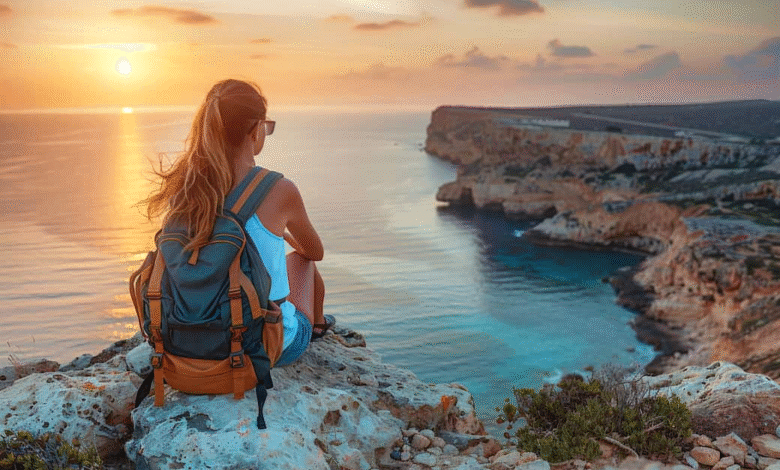Solo Female Travel Safety: Essential Tips for Independent Adventures
This comprehensive guide provides essential strategies, practical tips, and expert insights to help women navigate the exciting realm of solo adventures with confidence and peace of mind.

The world of independent travel beckons to millions of women seeking adventure, self-discovery, and cultural enrichment. While the prospect of exploring new destinations alone can be both thrilling and empowering, understanding solo female travel safety fundamentals is crucial for ensuring memorable and secure journeys. This comprehensive guide provides essential strategies, practical tips, and expert insights to help women navigate the exciting realm of solo adventures with confidence and peace of mind.
EXPLORE THE CONTENTS
Understanding the Landscape of Women Solo Travel
The rise of women’s solo travel has transformed the tourism industry, with female travelers now representing a significant portion of the global tourism market. According to recent industry reports, women account for approximately 84% of solo travelers, demonstrating a growing trend toward independent exploration. This shift reflects changing societal attitudes, increased financial independence, and a desire for authentic travel experiences.
Solo female travelers often seek destinations that offer rich cultural experiences, natural beauty, and opportunities for personal growth. However, the journey requires careful planning and awareness of potential safety challenges. Understanding these dynamics is the first step toward creating successful solo travel experiences.
The benefits of traveling alone as a woman extend far beyond simple sightseeing. Independent travel fosters self-reliance, builds confidence, and provides unparalleled opportunities for personal reflection and growth. Many female travelers report that solo journeys have been transformative experiences that shaped their perspectives and enhanced their problem-solving abilities.
Pre-Travel Planning for Female Solo Travelers
Effective solo female travel safety begins long before departure. Thorough research and meticulous planning form the foundation of secure independent travel. Start by investigating your chosen destination’s cultural norms, local customs, and current safety conditions. Government travel advisories, embassy websites, and reputable travel forums provide valuable insights into regional safety concerns and cultural expectations.
Create a comprehensive travel itinerary that includes accommodation details, transportation arrangements, and emergency contact information. Share this itinerary with trusted friends or family members who can serve as your safety network. Establish regular check-in schedules to maintain communication throughout your journey.
Financial planning plays a crucial role in travel safety. Diversify your monetary resources by carrying multiple payment methods, including cash in local currency, credit cards, and backup emergency funds. Research banking facilities and ATM availability at your destination to avoid being caught without access to funds.
Document preparation is equally important for solo female travel safety. Ensure your passport has adequate validity remaining and obtain necessary visas well in advance. Create digital and physical copies of important documents, storing them separately from originals. Consider registering with your embassy or consulate when traveling to certain destinations.
Choosing Safe Destinations for Solo Female Travel
Destination selection significantly impacts solo female travel safety outcomes. While personal preferences and interests should guide your choices, certain factors can help identify more suitable locations for independent female travelers. Countries with strong women’s rights records, low crime rates, and well-developed tourism infrastructure typically offer safer environments for solo female exploration.
Consider destinations known for their welcoming attitudes toward solo female travelers. Many European countries, parts of Asia like Japan and South Korea, and certain regions of Australia and New Zealand have earned reputations as particularly safe for women traveling alone. However, safety conditions can vary significantly within countries, making regional research essential.
Evaluate the transportation infrastructure and accommodation options available at potential destinations. Regions with reliable public transportation, regulated taxi services, and a variety of accommodation choices provide solo travelers with greater flexibility and security options. Look for destinations where women’s participation in public life is normalized and visible.
Climate and seasonal considerations also affect safety for solo female travelers. Research weather patterns, natural disaster risks, and seasonal variations in local conditions. Some destinations may be perfectly safe during certain times of year but present additional challenges during others.
Essential Safety Gear and Documentation
Proper preparation includes assembling essential safety gear tailored to solo female travel requirements. A well-equipped safety kit should include items that enhance security without creating unnecessary bulk or inconvenience. Personal safety devices, such as whistle alarms, personal alarms, and tactical flashlights, can provide additional security measures.
Communication devices are crucial for maintaining safety while traveling alone. Ensure your mobile phone is unlocked for international use and consider purchasing local SIM cards for better connectivity. Portable chargers and backup power sources prevent communication disruptions that could compromise your safety.
First aid supplies should be customized for both general health needs and specific destination requirements. Include basic medications, bandages, antiseptic supplies, and any prescription medications you regularly use. Research health risks specific to your destination and pack appropriate preventive measures.
Consider investing in quality luggage with security features such as lockable zippers, cut-resistant straps, and RFID-blocking compartments. These features help protect your belongings and important documents from theft or unauthorized access.
Read More: Top Scenic Coastal Walks to Explore in the UK 2025
Transportation Safety for Solo Female Travelers
Navigation through various transportation systems requires special attention to solo female travel safety principles. Research local transportation options thoroughly before arrival, including public transit systems, taxi services, and ride-sharing availability. Familiarize yourself with typical costs and common routes to avoid being taken advantage of by unscrupulous operators.
When using public transportation, maintain awareness of your surroundings and trust your instincts about potentially unsafe situations. Sit near other travelers when possible, especially families or other women. Keep your belongings secure and avoid displaying expensive items or large amounts of cash.
Taxi and ride-sharing services require additional precautions for solo female travelers. Use reputable companies with proper licensing and identification systems. Verify driver information matches the provided details and share your ride information with trusted contacts. Avoid accepting rides from unlicensed or unofficial taxi services.
Air travel considerations for solo female travelers include seat selection strategies, airport navigation, and layover management. Choose aisle seats when possible for easier access to restrooms and greater mobility. Arrive at airports with adequate time for security procedures and potential delays.
Accommodation Safety Strategies
Selecting appropriate accommodation is fundamental to solo female travel safety. Research accommodation options thoroughly, reading reviews from other solo female travelers when possible. Look for properties with strong security measures, 24-hour reception services, and positive safety ratings.
Consider the location of your accommodation relative to transportation hubs, restaurants, and attractions. Staying in well-lit, populated areas generally provides better safety conditions than remote or isolated locations. Evaluate the surrounding neighborhood’s safety reputation and accessibility.
Upon arrival, conduct a brief security assessment of your accommodation. Locate emergency exits, test door locks and security features, and familiarize yourself with hotel or hostel policies. Request rooms on higher floors when possible, as these are generally more secure than ground-level accommodations.
Maintain security protocols throughout your stay. Keep important documents and valuables in hotel safes or secure storage areas. Avoid sharing detailed itinerary information with accommodation staff beyond what is necessary for your safety and security.
Cultural Awareness and Appropriate Behavior
Understanding local customs and cultural norms is essential for solo female travel safety. Research dress codes, social behaviors, and cultural expectations before arrival. What may be acceptable behavior in your home country might be inappropriate or even dangerous in certain destinations.
Dress appropriately for local customs and religious considerations. Many cultures have specific expectations regarding women’s clothing, especially in religious sites or conservative communities. Packing versatile clothing that can be layered or adjusted for different cultural contexts helps ensure appropriateness.
Learn basic phrases in the local language, particularly those related to safety and emergency situations. Simple greetings, polite expressions, and emergency phrases can help you navigate cultural interactions more effectively and may be crucial in emergency situations.
Understand local laws and regulations that may affect solo female travelers. Some destinations have specific laws regarding women’s behavior, alcohol consumption, or interaction with local men. Ignorance of local laws does not provide protection from legal consequences.
Digital Safety and Communication
Maintaining digital security is increasingly important for solo female travel safety in our connected world. Protect your personal information by using secure Wi-Fi networks and avoiding public computers for sensitive transactions. Consider using a Virtual Private Network (VPN) to encrypt your internet connection when using public Wi-Fi.
Social media safety requires special attention for solo female travelers. Avoid posting real-time location information or detailed itinerary updates that could make you vulnerable to unwanted attention or criminal activity. Share your adventures after leaving locations rather than while you’re still present.
Backup your digital information regularly and store copies in multiple locations. This includes photos, important documents, and contact information. Cloud storage services can provide accessible backup options, but ensure they’re properly secured with strong passwords and two-factor authentication.
Maintain regular communication with your safety network without revealing sensitive information publicly. Establish private communication channels with trusted contacts who can assist in emergency situations or provide support when needed.
Emergency Preparedness and Response
Developing emergency preparedness skills is crucial for solo female travel safety. Create a comprehensive emergency plan that includes contact information for local authorities, your embassy or consulate, and trusted personal contacts. Research local emergency services numbers and procedures.
Identify potential emergency scenarios and develop response strategies for each. This might include medical emergencies, natural disasters, theft, or personal safety threats. Having predetermined plans reduces panic and improves response effectiveness during actual emergencies.
Carry emergency supplies appropriate for your destination and planned activities. This might include additional medications, emergency food supplies, water purification tablets, or region-specific emergency gear. Balance preparedness with practical packing limitations.
Learn basic first aid and self-defense techniques before traveling. While hopefully never needed, these skills can provide confidence and practical assistance in emergency situations. Many communities offer specialized self-defense courses designed for travelers.
Building Confidence and Trusting Instincts
Developing confidence and learning to trust your instincts are fundamental aspects of solo female travel safety. Confidence affects how others perceive and interact with you, potentially preventing dangerous situations from developing. Practice assertive communication and boundary-setting skills before traveling.
Learn to recognize and respond to uncomfortable situations appropriately. If something feels wrong, trust your instincts and remove yourself from the situation. It’s better to appear rude or overly cautious than to ignore warning signs that could indicate danger.
Develop situational awareness skills that help you assess your environment and potential risks. This includes observing body language, identifying escape routes, and recognizing suspicious behavior. Regular practice of these skills builds confidence and improves response times.
Build a support network of fellow travelers, locals, and accommodation staff who can provide assistance if needed. Having multiple people aware of your whereabouts and activities creates additional safety layers without compromising your independence.
Health and Wellness Considerations
Maintaining physical and mental health while traveling solo requires special attention for female travelers. Research health risks specific to your destination and take appropriate preventive measures. This might include vaccinations, prophylactic medications, or special health precautions.
Pack a comprehensive health kit that addresses both routine needs and potential destination-specific health challenges. Include feminine hygiene products, as these may be difficult to find or expensive in some destinations. Consider bringing extra supplies to avoid uncomfortable situations.
Mental health considerations are equally important for solo female travel safety. Traveling alone can be emotionally challenging, and being prepared for loneliness, culture shock, or homesickness helps maintain overall well-being. Develop coping strategies and maintain connections with your support network.
Understand local healthcare systems and insurance requirements. Research medical facilities at your destination and ensure your health insurance provides adequate coverage for international travel. Consider purchasing additional travel health insurance if needed.
Conclusion
Solo female travel safety requires comprehensive preparation, cultural awareness, and practical skills, but it should never prevent women from pursuing independent adventures. By implementing these essential safety strategies, female travelers can explore the world with confidence while minimizing risks and maximizing enjoyment.
The key to successful solo female travel lies in finding the balance between reasonable precautions and adventurous exploration. With proper planning, awareness, and preparation, women can safely navigate incredible destinations, create lasting memories, and develop valuable life skills through independent travel experiences.
Remember that solo female travel safety is an ongoing process of learning and adaptation. Each journey provides opportunities to refine your skills, build confidence, and expand your comfort zone. Embrace the transformative power of independent travel while maintaining the vigilance necessary for safe and successful adventures.
The world offers countless opportunities for solo female travelers willing to prepare properly and travel wisely. With these essential safety tips as your foundation, you’re well-equipped to embark on the independent adventures that await. Safe travels, and may your solo journeys be filled with discovery, growth, and unforgettable experiences.







